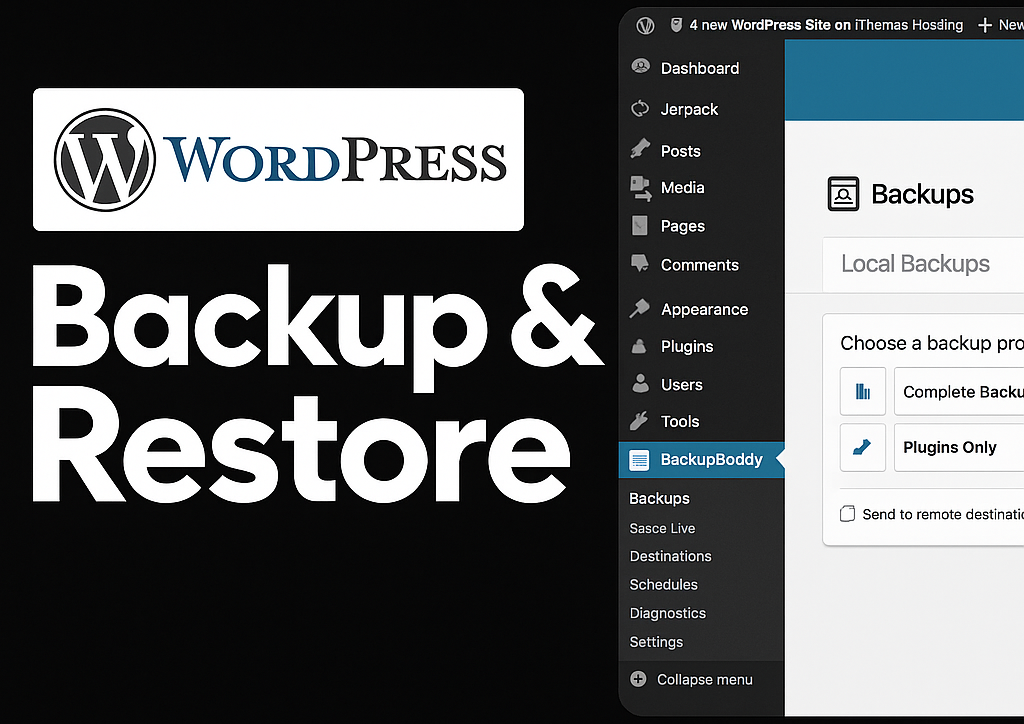Learn how to backup and restore a WordPress website step-by-step in 2025. Boost website security, prevent data loss, and master complete WordPress backup strategies. SEO optimized guide with FAQs.
Introduction
In today’s fast-paced digital world, every second your website is down can cost you traffic, revenue, and trust. If you own or manage a WordPress site, understanding how to backup and restore a WordPress website is non-negotiable.
A proper backup strategy helps you recover from hacking, plugin conflicts, user errors, server crashes, or even accidental deletions. In this comprehensive guide, we’ll explore every method—manual, plugin-based, automated—and provide a complete strategy so you never lose your data.
Let’s dive into how to backup and restore a WordPress website step by step.
Why Backup Your WordPress Website?
Backing up your site ensures that:
💾 Your files and database are protected
🧠 You have peace of mind
🔐 You can recover quickly in emergencies
🌐 Website migrations are smooth
Learning how to backup and restore a WordPress website will help you safeguard your content and avoid unnecessary stress.
Different Types of WordPress Backups
1. Full Backup
Includes your entire WordPress setup — files, database, themes, plugins, uploads.
2. Database Backup
Only includes data such as posts, comments, users, and settings.
3. File Backup
Backs up themes, plugins, images, and media files, excluding the database.
Understanding these types is essential before learning how to backup and restore a WordPress website properly.
Method 1: Manual Backup (No Plugin)
Step 1: Backup Website Files
Login to cPanel or connect via FTP (like FileZilla)
Open
public_htmlfolderDownload all files to your computer
Zip and save in cloud or hard drive
Step 2: Backup Database
Go to phpMyAdmin
Select your database
Click Export > Quick > SQL > Go
Save the
.sqlfile
Although manual backup gives full control, it requires technical skills. Beginners learning how to backup and restore a WordPress website should proceed carefully.
Method 2: Backup Using Plugins
Here are top plugins to simplify how to backup and restore a WordPress website:
🔄 UpdraftPlus
Install the plugin
Go to Settings → UpdraftPlus
Click “Backup Now”
Select database + files
Choose remote storage (Google Drive, Dropbox)
📦 Duplicator
Perfect for site migration + backup:
Install plugin
Create a new package
Download both files
Use installer.php to restore
🛡️ Jetpack Backup
Real-time backup + restore (premium)
Ideal for WooCommerce or active blogs
🔃 BlogVault
Enterprise-grade automatic backups with staging and 90-day history.
Using any of these plugins is the easiest way to master how to backup and restore a WordPress website.
Method 3: Automated Hosting Backups
Some premium WordPress hosts offer built-in daily backups:
Kinsta
SiteGround
Rocket.net
Bluehost (with CodeGuard)
But don’t depend solely on host backups—learning how to backup and restore a WordPress website gives you control and independence.
How to Restore a WordPress Website
Manual Restoration
Step 1: Restore Files
Login to hosting panel or FTP
Upload all saved files to
public_htmlOverwrite existing files if needed
Step 2: Restore Database
Go to phpMyAdmin
Select existing database → drop all tables
Click Import → Choose
.sqlfile → Go
This is the traditional way for tech-savvy users who know how to backup and restore a WordPress website.
Plugin-Based Restoration (Recommended)
Using UpdraftPlus
Go to UpdraftPlus → Existing Backups
Click Restore
Select files/database
Confirm and wait
It’s the most user-friendly option to restore your WordPress site quickly and safely.
Best Practices for Backup & Restore
🔁 Schedule Daily/Weekly Backups
☁️ Use Remote Storage (Google Drive, Dropbox)
🧪 Test Backups Periodically
🗂️ Keep Multiple Backup Versions
🔄 Backup Before Every Major Update
Understanding these practices is part of mastering how to backup and restore a WordPress website.
How Often Should You Backup?
| Website Type | Recommended Frequency |
|---|---|
| Blog | Weekly |
| eCommerce | Daily or Real-Time |
| Static Site | Monthly |
| News/Media | Hourly or Daily |
Backup frequency should reflect your content update frequency.
Common Backup Mistakes
❌ Relying only on hosting backups
❌ Not testing restore points
❌ Storing backups on the same server
❌ Forgetting to backup before updates
Avoiding these mistakes is essential when learning how to backup and restore a WordPress website effectively.
Extra Tip: Use Staging Sites
Before restoring or updating your main site:
Clone it to a staging environment
Test new changes
Apply only after confirming
It reduces downtime and errors.
FAQs – How to Backup and Restore a WordPress Website
Q1. What is the best plugin to backup a WordPress site?
UpdraftPlus is the most popular and reliable option, offering free and premium features.
Q2. How do I restore my site without a plugin?
Manually upload files via FTP and restore the database using phpMyAdmin.
Q3. How often should I backup my website?
Daily for active sites, and weekly for moderate activity. Use automated schedules.
Q4. Where should I store my backups?
Always use off-site storage: Google Drive, Dropbox, Amazon S3, or external HDDs.
Q5. Can I migrate my site with these backups?
Yes! Tools like Duplicator and UpdraftPlus allow full site migration.
Conclusion
Learning how to backup and restore a WordPress website is not just a good-to-have skill—it’s a must-have for any website owner in 2025. Whether you’re a blogger, business owner, or developer, regular backups are your insurance against data loss.
👉 Choose a method (manual or plugin-based)
👉 Schedule regular backups
👉 Test restoration on a staging site
👉 Store backups in multiple locations
Once you master how to backup and restore a WordPress website, you’ll have complete peace of mind knowing your hard work is safe.














